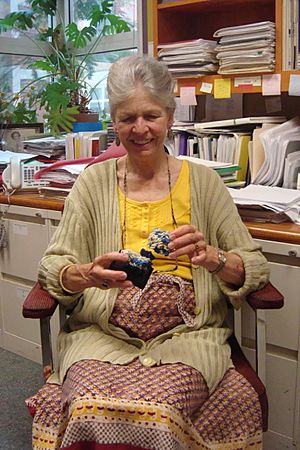Joan A. Steitz facts for kids
Quick facts for kids
Joan Steitz
|
|
|---|---|
 |
|
| Born |
Joan Elaine Argetsinger
January 26, 1941 Minneapolis, Minnesota, US
|
| Education | Antioch College (BS) Harvard University (PhD) |
| Known for |
|
| Spouse(s) | Thomas Steitz |
| Children | 1 |
| Awards |
|
| Scientific career | |
| Fields | |
| Institutions | |
| Thesis | Studies of the R17A protein (1968) |
| Doctoral advisor | James D. Watson |
| Doctoral students | Sandra Wolin, Gia Voeltz |
Joan Steitz (born January 26, 1941) is a famous American scientist. She is a biochemist and molecular biologist. She works as a professor at Yale University and is also a researcher at the Howard Hughes Medical Institute.
Dr. Steitz is known for her amazing discoveries about RNA. RNA is like a messenger molecule in our bodies. She found out how ribosomes (tiny cell parts that make proteins) read messages from messenger RNA (mRNA). She also discovered special tiny particles called small nuclear ribonucleic proteins (snRNPs). These snRNPs help to cut out unneeded parts from RNA messages in living things like humans.
In September 2018, Dr. Steitz received the Lasker-Koshland Special Achievement Award in Medical Science. This award is often called the 'American Nobel' because many winners later win a Nobel Prize.
Contents
Early Life and Education
Joan Steitz was born in Minneapolis, Minnesota. She grew up there in the 1950s and 60s. She went to an all-girls high school that offered only a few science classes.
In 1963, Joan earned her first degree in chemistry from Antioch College in Ohio. This is where she first became interested in molecular biology. She worked as an intern at a lab at the Massachusetts Institute of Technology.
After college, Joan thought about going to medical school. She knew of women doctors but not many women scientists. However, she loved working in a science lab during a summer. So, she decided to apply to Harvard's new program for biochemistry and molecular biology instead. At Harvard, she was the first woman graduate student to join the lab of James Watson. He was a Nobel Prize winner. She started her research there by studying bacteriophage RNA.
Amazing Discoveries in Science
After Harvard, Dr. Steitz did more research in the UK at the Medical Research Council (MRC) Laboratory of Molecular Biology. She worked with other famous scientists like Francis Crick. There, she studied how bacteria know where to start reading the instructions on mRNA.
In 1969, she published an important paper in the journal Nature. It showed the exact starting points on a virus's RNA where it connects to bacterial ribosomes to make proteins.
How Cells Read Messages
In 1970, Dr. Steitz joined the faculty at Yale University. In 1975, she made a big discovery. She showed that ribosomes use a special matching system, like puzzle pieces fitting together, to find the right starting spot on mRNA. This is called complementary base pairing.
Discovering snRNPs
In 1980, Dr. Steitz and her colleague Michael Lerner made another huge discovery. They found tiny particles called snRNPs (pronounced "snurps"). They learned that snRNPs play a key role in a process called splicing.
Splicing is super important! When our genes make an RNA message, it often has parts that aren't needed, called introns. SnRNPs are like tiny scissors that cut out these unneeded introns from the RNA. This makes the RNA message ready to be used to build proteins. Dr. Steitz's work helped us understand how our cells process genetic information.
Introns Are Not "Junk DNA"
Dr. Steitz later found another type of snRNP particle called snoRNP. She showed that introns, which were once thought to be "junk DNA" (meaning useless parts), actually contain instructions for making snoRNPs.
Her work helped explain why humans can do so much with relatively few genes. She said that because of splicing, our cells can cut and combine parts of the RNA message in different ways. This means one gene can make slightly different proteins, which can do slightly different things. It's like getting many different recipes from one cookbook!
Helping with Health
Dr. Steitz's research also helps us understand autoimmune disorders. These are diseases like lupus, where a person's immune system mistakenly attacks their own body. Her work helps explain why patients with these conditions sometimes make antibodies against their own snRNPs.
Dr. Steitz has also been a strong supporter of women in science. Many people see her as one of the greatest scientists of our time.
Personal Life
Joan Steitz (born Joan Argetsinger) married Thomas Steitz in 1966. He was also a professor at Yale and won the Nobel Prize in Chemistry in 2009. They have one son named Jon.
Awards and Honors
Dr. Joan Steitz has received many important awards for her scientific work. Some of them include:
- 2021 – Wolf Prize in Medicine
- 2018 – Lasker-Koshland Award for Special Achievement in Medical Science
- 2006 – Gairdner Foundation International Award
- 1986 – National Medal of Science
- 1982 – NAS Award in Molecular Biology
Her nomination for the Royal Society said that she is a pioneer in RNA biology. It highlighted her discoveries about how ribosomes start making proteins, how spliceosomes (which contain snRNPs) cut RNA, and how introns are not junk but can make snoRNAs. She also found new roles for microRNAs in controlling genes.
See also
 In Spanish: Joan A. Steitz para niños
In Spanish: Joan A. Steitz para niños

